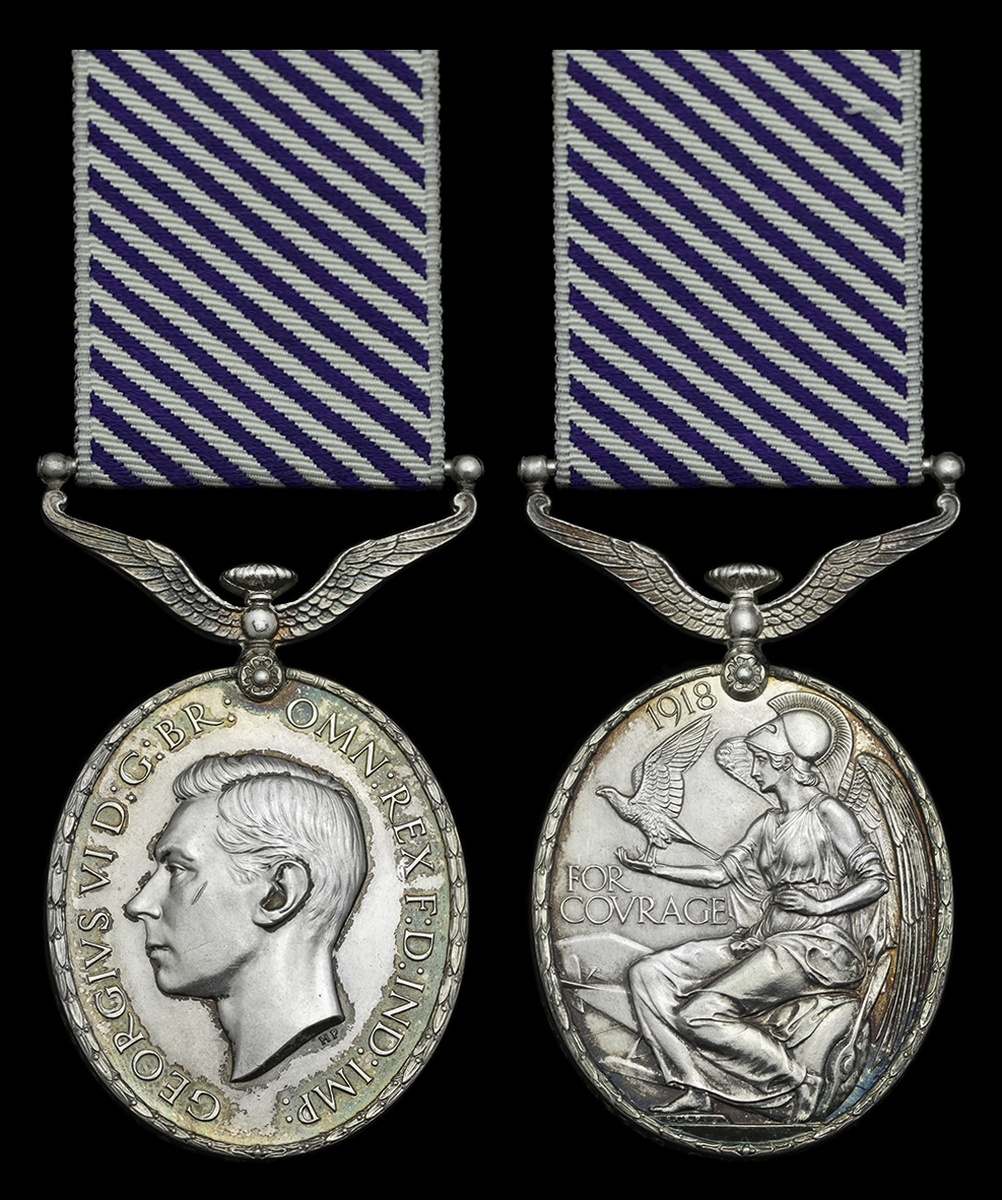
Auction: 24003 - Orders, Decorations and Medals
Lot: 221
The Immediate Battle of France 1940 D.F.M. awarded to Air Gunner/Wireless Operator Leading Aircraftman R. W. J. Green, No. 226 Squadron, Royal Air Force, who served with the 'Air Striking Force' during the Battle of France, strafing German Armoured columns in low altitude attacks by Day and Night
Green was later killed in action over Nordeney when his Blenheim was ripped to pieces by flak, leaving no survivors
Distinguished Flying Medal, G.VI.R. (547790 L.A.C. R. W. J. Green. R.A.F.), suspension a little loose, nearly very fine
Provenance:
Spink, April 2006.
D.F.M. London Gazette 25 June 1940, the original joint citation states:
´During a day [28th] in May, 1940, Pilot Officer Crooks carried out an extensive reconnaissance of the Amiens-Albert road with great determination and gallantry. At a low altitude, and under heavy fire from the ground, he bombed a large convoy of enemy armoured vehicles, obtaining direct hits with his bombs. Although his aircraft was hit by heavy pom-pom fire he succeeded in reaching his base. Sergeant Davies, an air observer, has been a member of Pilot Officer Crook´s crew on all missions, and has used his gun most effectively during low flying bombing attacks on convoys. He has also shown exceptional navigational ability under difficult conditions by day and night. As wireless operator, air gunner in Pilot Officer Crook´s aircraft, Leading Aircraftman Green has displayed considerable gallantry in attacking ground targets from a low altitude with his rear gun. Pilot Officer Crooks and his crew have shown initiative and exceptional devotion to duty in many missions undertaken by night and under adverse weather conditions. They have pressed home their attacks, invariably from low altitudes, in spite of enemy opposition from the ground and from the air.´
Reginald William John Green born Newbury, Berkshire in 1920 the son of William and Sasha Green. He was living at Finchley prior to the war in 1936 and enlisted prior to the opening of hostilities in 1938, being posted to No. 226 Squadron flying Fairey Battles. He was still with this unit on the outbreak of the Second World War and joined them at Faux-Villecerf in 1940 for the Battle of France.
Green flew with Pilot Officer Crooks, D.F.C. on operations in France as part of the RAF's 'Advanced Air Striking Force', a Light Bombing until composed of aircraft from Group 1, Bomber Command. This unit was intended to allow short range bombers to Operate within France, striking at Military targets within Germany however during the Phoney War fears of provoking the Germans prevented their use. Instead they found themselves used to support ground troops by attacking Military columns and logistical support.
Green was serving as Wireless Operator/ Air Gunner in this period flying his first mission over Boeimer, South West of Breda on 10 May 1940. They continued to attack troop movements with the Operations Records noting such instances as 'Fuse bombs dropped on wood alongside road one mile West of Hauteville...Fairly heavy A.A. fire' and 'on convoy, on road North of Florenville and Neufchateau'.
Not all the attacks were dive bombing runs however, with Green very much in the action, machine gunning any targets he could. The Operations Record notes one raid over Florenville on 23 May 1940 in which he spotted a 'Large convoy moving West, machine-gunned this at 1000ft on road Florenville to Carignan (4 miles south of Florenville). Another convoy moving South West on Florenville-Carignan road, machine-gunned this from 1000ft (4 miles S.W. of Florenville). Convoy replied with intense machine gun fire.'
However it was for the operation of 28 May that Green was to be awarded his D.F.M. and Crooks the D.F.C. The Operation Record records the following from that day:
´Four bombs (slow stick, shallow dive, 5000-2000ft) dropped at 0250 hrs, Target Conz. Bombs seen to burst between houses and river bank. Flew South along railway from Conz to Sierck. Two trains, one moving South and one moving North about one mile South of Nittel. Machine gunned by rear gunner (3 pans) and 11 pans of Observers gun. Dived to 1000ft on train moving South and fired front gun. Intense A.A. fire from ground after firing on train. 36 searchlights in target area.´
It must be remembered that this attack was conducted in a Fairey Battle, an aircraft famous for being vulnerable to both aircraft attack and ground fire. Despite the Crooks and his crew undertook repeated attacks along with Amiens-Albert Road at a critical time during the Battle of France under heavy fire. Their aircraft was even damaged by ground fire and despite this they succeeded in nursing it home, quite a feat under the circumstances and all after eighteen days of intense operational flying.
Green and the crew's observer, Davies, received their medals on a parade at Sydenham Aerodrome on 17 September 1940. Crooks was posted to Fighter Command on the return to Britian however Green and Davies kept flying together, transferring to Blenheim's under Wing Commander R. G. Hurst, in aircraft Z7391. Sadly Crooks, by then a Flight Lieutenant, was hit by return fire while engaging an enemy over Helston and died in the resulting crash.
This aircraft took off from Wattisham on 4 July 1941 for a raid over Nordeney, one of the East Frisian Islands. They approached their target with no problems however as they turned away they came under intense flak fire which brought them down over the sea, there were no survivors of the disaster. Green is buried in the Safe War Cemetery, Oldenburg, Germany; sold together with copied research.
Subject to 20% VAT on Buyer’s Premium. For more information please view Terms and Conditions for Buyers.
Estimate
£2,400 to £2,800
Starting price
£2200




